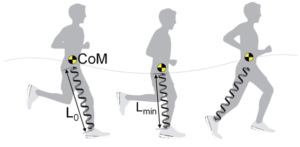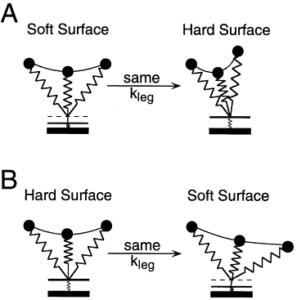Imagine that you are on your typical route for a morning run when you decide to change things up. Instead of following the path of the sidewalk like usual, you take a shortcut across the soft grass and run alongside the concrete for awhile. No big deal, right?

Although this change in running surface may not seem to be a big deal, there is a lot more going on behind the scenes than runners are consciously aware of. As you step from the firm concrete to the soft soil, your body automatically adjusts its stride to accommodate the change and you hardly notice the difference. Specifically, your legs calibrate their angle relative to the ground and tension in the quadriceps before taking a step onto a new surface to maintain balance and speed as you run.
In a study performed by Daniel Ferris et al., researchers examined the mechanics of surface-dependent running. Participants ran at a constant speed across a track with both a rigid and a compliant surface, and the force of the leg, time of foot-to-ground contact, and angle of the leg at initial ground contact were measured for each trial. The resulting data were then analyzed by modeling the legs of the runners as simple springs (left). The research concluded that runners quickly and instinctively adapt the stiffness of their legs in response to changes in surface elasticity. This allows runners to keep a constant running speed without wasting energy due to excessive vertical motion of the torso as the body adjusts to the new surface.
Without this intrinsic adaptation of leg stiffness, runners would have to drastically change their strides to remain upright as they ran from surface to surface (right, with stiffness denoted as kleg). In fact, leg stiffness decreases when you run on rigid surfaces and increases when you run on springy surfaces. In short, the stiffness of your legs compensates for the firmness of the ground you are running on.
So how does leg stiffness translate to injuries and injury prevention?
First of all, it is important to note that injuries to muscles and ligaments have different causes and symptoms than injuries to the bone. Knowing this, experts suggest preventative measures specific to the type of injury. For example, one article claims that high leg stiffness while running corresponds to a higher risk of bone injuries. As a result, we can use the information above to deduce that the best way to prevent stress fractures is to run on hard surfaces such as concrete or asphalt in shoes with little cushioning. Conversely, low leg stiffness corresponds to a higher risk of muscle and ligament injuries and the best way to prevent these injuries is to run on dirt, grass, or a track in padded shoes. The video below explains this correlation in further detail.
See also padded shoes paradox and leg stiffness and running performance for further reading.
Featured image by MabelAmber on Pixabay


